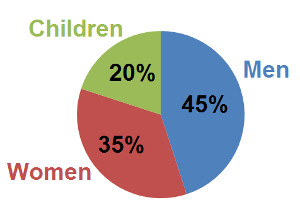
Above graph represents population of a Town divided into three parts i.e. Men, women and children
Such circular graphs are known as Pie Graphs . Pie Graphs are also known as Circle Graphs or Pie Chart
Such graphs show relationship between a whole and its parts or sectors and it is also used to show comparison of different parts or sector of a whole. The size of each part or sector is proportional to the activity or data its represents.
As shown in the above pie graph:
Whole part or circle represents the total population of a town. And three parts or sectors highlighted with blue, red and green represents percentages of men, women and children population.
|






